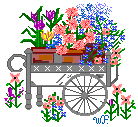
Cutting Gardens
To the best of my knowledge
All Images on the Garden pages
Are Public Domain. If you see one
That is copyright, email me,
And I Will
Remove It

The beauty of flowers that draws us to
them is magnified when we bring them indoors to enjoy. Growing flowers is a rewarding experience, but being able to arrange flowers into artistic visions brings new meaning to gardening. Flowers is are a spiritual exercise, whether the flowers are in the garden or in a vase. A flower arrangement also makes a nice gift - a nice way to share the beauty of your garden with friends.

Growing and arranging cut flowers is not hard. Over one summer, you can grow an assortment of blooming flowers and shrubs and learn a few easy procedures that enhance the them when they are displayed. Working with cut flowers is alittle learned skill, and alittle free expression.

People have grown and used cut flowers for thousands of years. Some of the oldest cutting gardens known weren't gardens at all. Water lilies that bloomed in the backwaters of the Nile. From as early as 2000 B.C. there is evidence that Egyptians created and used vases that could hold the huge water lily blossoms, which are often more than six inches across. More than a thousand years later, other flowers including safflowers and corn poppies began appearing in mortuary garlands placed in the
more elaborate tombs.

In Europe the development of civilized cultures in Greece and Rome brought increased interest in cutting and using flowers gathered from the hillsides and grown in gardens. But rather than displaying flowers in the containers, it became the custom to wear wreaths of flowers on the head and garlands around the neck. By this time roses had become quite popular, as well as violets and lilies. The blossoms were often woven with cuttings from vines and shrubs such as laurel, olive, ivy, and grape. In addition, fragrant and medicinal herbs were collected and dried in almost every household.

Medieval gardens were kept in monasterys,
and by the time Renaissance artists began celebrating beauty in their works, many cut flowers had been thoroughly suffused with religious and superstitious meanings. Roses symbolized heaven and love. The white lily and iris were associated with fertility and the Virgin Mary. By the 1500s flower gardens were all over Europe, and bringing cut flowers indoors, where they could be enjoyed casually in many types of containers. Keeping in mind that the homes of the day were quite odorous due to the lack of plumbing and standards of personal hygiene, it is certainly no wonder that fragrant flowers such as rose, rocket, and carnation became popular garden subjects.

Today, the gardens of Europe show an assortment of faddish styles that came and went in time, but gardens are often are lush in vibrant color. A rich border filled with alot of different flowers has become the way to define domestic space, and no wall or entrance is considered complete without a bed, box, or arbor of flowers. It is not surprising that the European tradition of flower arranging is best represented by bouquets filled with many types
of flowers. This tradition transplanted easily to the New World, and vases filled with flowers remain the most widely used way to celebrate the flowers of summer in the Western world. However, American flower arrangers in search of innovative ways to express themselves found, during the 1950's and 60's, when they began tinkering with flower arranging traditions from Japan.

If you want one of my site banners click here.
© 1997 1998...

This page has been visited times.
Site Designed With
